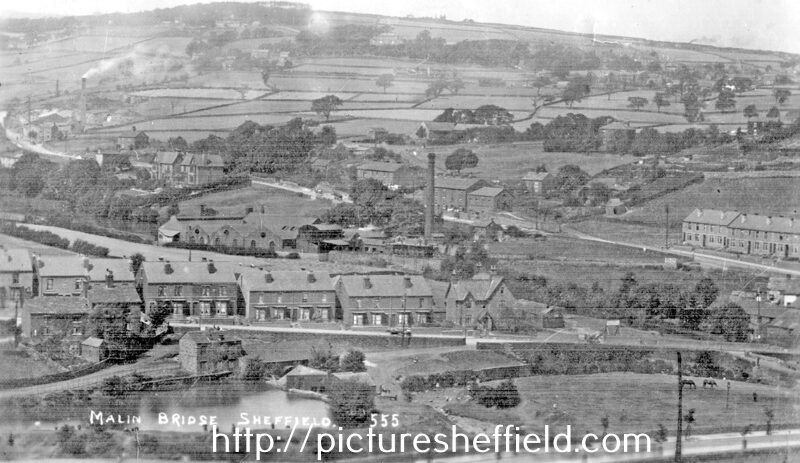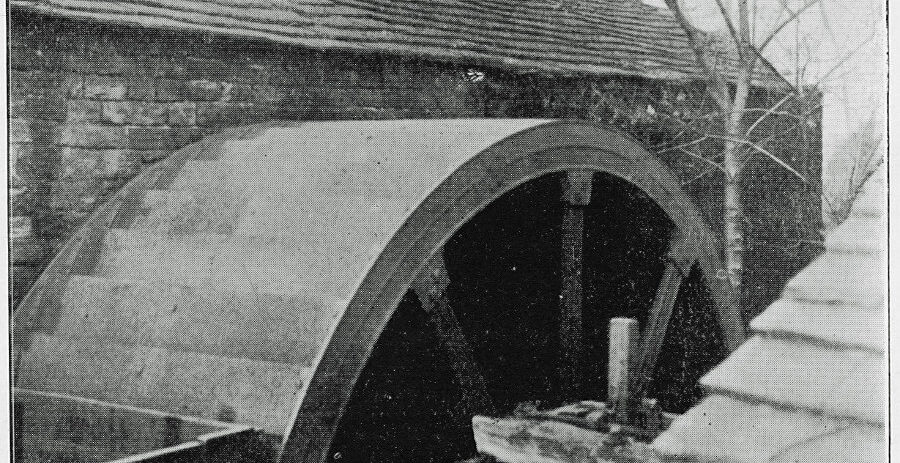
Introduction
Grogram Wheel is the last site downstream on the Rivelin, with the outfall being close to the confluence of the Rivelin and Loxley rivers at Malin Bridge. It was built in the early 17th century and was one of the last to be in ruins (by 1949). It was used for grinding and to pump air to the Mousehole Forge furnaces through cast-iron pipes.
The weir, a short, blocked head goit and the outfall from the tail goit into the river are all that remains at the Grogram site. The mill dam was infilled and is now the site of an electricity sub-station.
History (c. 1620s–1935)
Also known as: Groggerham Wheels, Saw Mill.
Main trades: Grinding cutlery, files, sickles, anvils & hammers; bean crushing; lathe; air supply for Mousehole Forge furnaces.

Dating from the 1620s (or perhaps before), Grogram Wheel was amongst the earliest to be built in the valley. There were two workshops, each with a waterwheels – these were located next to each other between the two buildings. The larger of the two waterwheels, known affectionately as the ‘Groggie’ amongst the locals, was said to be the largest in the valley and at one time ran 12 cutler’s trows; the smaller waterwheel ran six trows.

The Grogram Wheel and its much larger upstream neighbour, the Mousehole Forge, were purchased in 1842 by Henry Armitage from Lady Burgoyne for £2,100. Records show that in 1852, Grogram was grinding (finishing) anvils and hammers, and had a lathe, bean crusher and blowing apparatus. In the mid-19th century, the larger Grogram waterwheel was used to supply extra air for the furnaces at Mousehole Forge, the two sites being connected by large cast-iron pipes.

Being the closest to Malin Bridge, the Grogram waterwheels were the only ones in Rivelin to be damaged by the Great Sheffield Flood of 1864, when water backed-up on the Rivelin due to the high flood water in the River Loxley at Malin Bridge. The claim for damage and stoppage, including wages for clearing up and repairs, amounted to £440 4s 4d (although only £170 was allowed).
The ‘Groggie’ ceased to operate around 1933 and it was reported in The Sheffield Star newpaper that the main building was demolished in 1935 [Click the image below to see the full article]. By 1949 the waterwheel was in ruins.
What's there now?
The weir, a short, blocked head goit and the outfall from the tail goit into the river are all that remains at the Grogram site. On the south side, the wide weir has a typical block-stone slope, but on the northern side the river cascades over a straight, vertical stone wall. Unfortunately, this weir was badly damaged during Storm Babet in October 2023. Look closely at the river bank and island just below the weir and you will see metallic waste material from the nearby Mousehole Forge that has solidified over the rocks.

The river bank and island just below the Grogram weir are covered in solidified metallic waste material from the nearby Mousehole Forge. Photo: Sue Shaw, April, 2019.
The outline of the mill dam can still be seen, including the dam wall, but it was infilled and an electricity sub-station built there. The site of the former mill buildings is now covered in trees.
Nature and wildlife at Grogram Wheel
Around the Grogram Wheel site can be found some of the most common trees in the valley: Alder, Ash, Crack Willow, Elder, Goat Willow and Sycamore. There is also a variety of common wild flowers such as Cow Parsley, Cleavers, Herb Bennett, Herb Robert and White Deadnettle.
There is a large Wych Elm on the river bank beside the weir, as well as Alder, Hawthorn and Sycamore.
Location
Grogram Wheel is the last site downstream on the Rivelin, with the outfall being close to the confluence of the Rivelin and Loxley Rivers at Malin Bridge. The former mill dam site is privately owned, but the remainder is owned by Sheffield City Council and there is open access. A public bridleway passes the site and can be easily accessed from both Stannington Road and Rivelin Valley Road.
A marker post installed at the site by Rivelin Valley Conservation Group gives a brief history and links to this website.
Grid reference: SK 3251 8919
Nearest postcode: S6 5FL.

